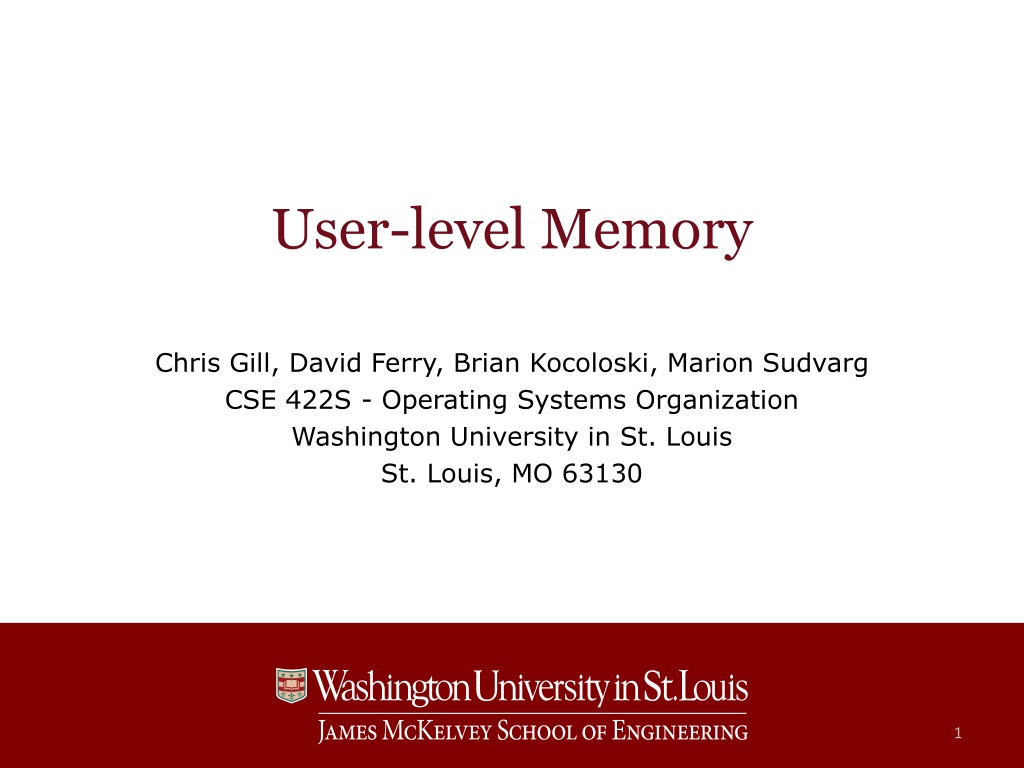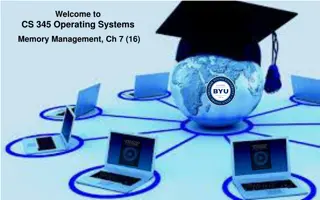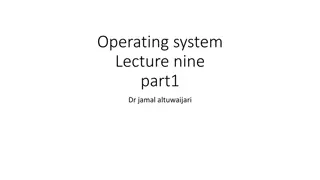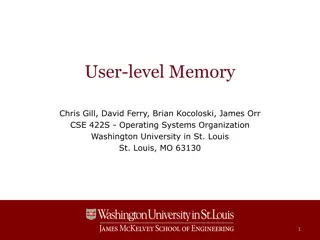Understanding User-Level Memory Management in Operating Systems
Exploring user-level memory concepts such as virtual memory areas, address spaces, paging, forking, and copy-on-write in the context of Linux operating systems. Learn about virtual/physical memory relationships, virtual address translation, process address spaces, and the use of techniques like copy-on-write for efficient process creation.
Download Presentation

Please find below an Image/Link to download the presentation.
The content on the website is provided AS IS for your information and personal use only. It may not be sold, licensed, or shared on other websites without obtaining consent from the author. Download presentation by click this link. If you encounter any issues during the download, it is possible that the publisher has removed the file from their server.
E N D
Presentation Transcript
User-level Memory Chris Gill, David Ferry, Brian Kocoloski, Marion Sudvarg CSE 422S - Operating Systems Organization Washington University in St. Louis St. Louis, MO 63130 1
Virtual Memory Areas Recall virtual/physical memory relationship Pages are mapped to virtual memory Virtual addresses require translation Virtual Address Translation: Process A Process B Virtual Address Page# Offset 4KB 4KB 4KB 4KB 4KB 4KB Physical Page Phys. Addr CSE 422S Operating Systems Organization 2
/proc/<pid>/maps The valid virtual addresses in a process $ cat /proc/self/maps CSE 422S Operating Systems Organization 3
Process Address Spaces task_struct mm_struct vm_area_struct mm mmap mm_count start_code end_code vm_start vm_end vm_page_prot vm_flags vm_prev vm_next Each user space process has an address space Pointer to mm_struct is NULL in kernel threads Points to list of available memory areas (vm_area_struct , or VMA ) Identifies code, data, heap, and stack segments Is reference counted (mm_count is 2+ if shared) vm_area_struct vm_prev vm_next Address space has a flat range of addresses Segmentation fault occurs if the process accesses an address outside its allowed address segments vm_area_struct vm_prev vm_next CSE 422S Operating Systems Organization 4
Paging Review PML Linux terminology for 4-level page tables PML: Page Map Level PGD: Page Global Directory PMD: Page Middle Directory PTE: Page Table Entry PGD PMD Physical Page (4KB) PTE CSE 422S Operating Systems Organization 5
Forking and Copy-on-Write Recall that in our discussion of process creation, we saw that Linux relies on a technique called copy-on-write (CoW) CoW is used to make process creation fast All virtual memory segments in the parent process can be accessed by the child process But as soon as either the parent or child writes to a memory location, their address spaces point to different physical pages Relies on the virtual memory subsystem (including paging on paged-systems) to enforce this behavior CSE 422S Operating Systems Organization 6
Metadata in Page Table Entries Index MetaData (r/w/x) (present) Page Address for next level of page table 0 342 P: 0 R: 1 W:0 X: 0 0x1234 . 511 Recall the metadata bits within page table entries Present (P): is the next level of page table (or the physical page address, if we re at the last level) present? R/W/X: three separate bits indicating whether the memory is readable, writable, and/or executable CSE 422S Operating Systems Organization 7
Fork + CoW PML PML Process A ( parent ) Process B ( child ) PGD PGD Set PTEs as unwritable PMD PMD PTE PTE Physical Page (4KB) CSE 422S Operating Systems Organization 8
Fork + CoW PML PML Process A ( parent ) Process B ( child ) PGD PGD Physical Page (4KB) PMD PMD As soon as either A or B writes to the page Page fault (because PTE unwritable) Allocate new physical page Update both PTEs to be writable New Physical Page (4KB) PTE PTE CSE 422S Operating Systems Organization 9
Kernel Source Pointers kernel/fork.c _do_fork() call copy_process() copy_process call copy_mm() copy_mm call dup_mm() dup_mm call dup_mmap() dup_mmap call copy_page_range() mm/memory.c copy_page_range Recursively copies all page table entries over this address range CSE 422S Operating Systems Organization 10
Shared Memory use is Efficient Shared Memory refers to situations where different processes access same physical pages Same address translation as usual Virtual addresses map to same physical page(s) Page(s) can be readable/ writable by both processes, writable by one process / readable by the other, etc. Process A Virtual Address Process B Virtual Address Page# Page# Offset Offset Physical Page CSE 422S Operating Systems Organization 11
Shared Memory Concepts Processes may share physical memory region Communicate by modifying memory values Kernel only invoked at creation & deletion Reads/writes incur standard memory use costs Physical Address (e.g. 0x1000) 1 1 2 3 5 8 13 Process A Process B shm_ptr shm_ptr CSE 422S Operating Systems Organization 12
Shared Memory Process A Process B PML PML Some virtual address in process A maps to the same physical address as some virtual address in process B Do the virtual addresses have to be the same if the physical addresses are? PGD PGD PMD PMD Physical Page (4KB) PTE PTE CSE 422S Operating Systems Organization 13
Shared Memory Uses: (v)Forking/Cloning fork(), vfork(), pthread_create(), etc.: All use sys_clone() system call sys_clone flags (LKD pp. 35) Creating threads : CLONE_VM | CLONE_FS | CLONE_FILES | CLONE_SIGHAND i.e., share address space, filesystem metadata, open files, and signal handlers Creating processes (fork): No flags needed Creating processes (vfork): CLONE_VFORK | CLONE_VM CSE 422S Operating Systems Organization 14
vFork and thread creation PML PML Process A ( parent ) Process B ( child ) Any virtual address maps to the same physical address in both processes A and B PGD Main benefit of vfork() Page tables do not need to be copied in new process/ thread What types of programs would benefit from this? PMD PTE Physical Page (4KB) CSE 422S Operating Systems Organization 15
Memory Mapping and Unmapping Kernel creates a new address interval The do_mmap function specifies access permissions, may back it with a file (or may leave it anonymous) The do_munmap function removes the interval from the process address space May use vm_area_cachep (slab allocation) User processes also may initiate memory mapping Via the mmap() C library function Useful for shared memory based communication between processes: see man 7 shm_overview CSE 422S Operating Systems Organization 16
Todays Studio: Using Shared Memory in Linux Three steps to use shared memory 1. Create a shared file descriptor via shm_create() 2. Resize shared region via ftruncate() 3. Map region into process via mmap() Shared regions are identified by name Creator can specify user-level permissions CSE 422S Operating Systems Organization 17
Shared Memory Caveats Basic interface: void* (untyped pointer) Programmer must impose organization on shared memory region, manipulate the pointer accordingly E.g., casting pointer to specific type according to how sharing processes have laid out memory use Provides multi-threaded-like environment But concurrency libraries (and others) may or may not work when shared across processes E.g. pthreads PTHREAD_PROCESS_SHARED etc. May need to write your own concurrency code! CSE 422S Operating Systems Organization 18























